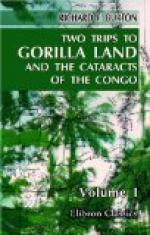We now reach the confluence of the Nkonio or north-eastern, with the Mbokwe, or eastern branch, which anastomose to form the Gaboon; the latter, being apparently the larger of the two, preserves the title Mpolo. Both still require exploration; my friend M. Braouezzec, Lieutenant de Vaisseau, who made charts of the lower bed, utterly failed to make the sources; and the Rev. Mr. Preston, who lived seven months in the interior, could not ascend far. Mr. W. Winwood Reade reached in May, 1862, the rapids of the Nkomo River, but sore feet prevented his climbing the mountain, which he estimates at 2,000 feet, or of tracing the stream to its fountain. Mr. R.B.N. Walker also ascended the Nkomo for some thirty miles, and found it still a large bed with two fathoms of water in the Cacimbo or “Middle dries.” In M. du Chaillu’s map the Upper Nkomo is a dotted line; according to all authorities, upon the higher and the lower river his direction is too far to the north-east. The good Tippet declares that he once canoed three miles up the Mbokwe, and then marched eastward for five days, covering a hundred miles—which is impossible. He found a line of detached hills, and an elevation where the dews were exceedingly cold; looking towards the utterly unknown Orient, he could see nothing but a thick forest unbroken by streams. He heard from the country people traditions of a Great Lake, which may be that placed by Tuckey in north latitude 2deg.-3deg.. The best seasons for travel are said to be March and November, before and after the rains, which swell the water twelve feet.
About Anenge-nenge we could easily see the sub-ranges of the great Eastern Ghats, some twenty miles to the north-east. Here the shallows and the banks projecting from different points made the channel dangerous. Entering the Mbokwe branch we were compelled to use sweeps, or the schooner would have been dashed against the sides; as we learned by the trees, the tides raise the surface two to three feet high. After the third hour we passed the “Fan Komba Vina,” or village of King Vina. It stood in a pretty little bay, and the river, some 400 feet broad, was fronted, as is often the case, by the “palaver tree,” a glorious Ceiba or bombax. All the people flocked out to enjoy the sight, and my unpractised eye could not distinguish them from Bakele. Above it, also on the right bank, is the now-deserted site where Messrs. Adams and Preston nearly came to grief for bewitching the population with “bad book.”
Five slow hours from Anenge-nenge finally placed us, about sunset, at Mayyan, or Tippet Town. The depot lies a little above the confluence of the Mbokwe and the Londo, or south-eastern fork of the latter. A drunken pilot and a dark and moonless night, with the tide still running in, delayed us till I could hardly distinguish the sable human masses which gathered upon the Styx-like stream to welcome their new Matyem—merchant or white man. Before landing, all the guns on




